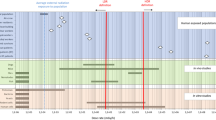Summary
Absorbed doseD is shown to be a composite variable, the product of the fraction of cells hit (I H ) and the mean “dose” (hit size)z to those cells.D is suitable for use with high level exposure (HLE) to radiation and its resulting acute organ effects because, sinceI H = 1.0, it approximates closely enough the mean energy density in the cell as well as in the organ. However, with low level exposure (LLE) to radiation and its consequent probability of cancer induction from a single cell, stochastic delivery of energy to cells results in a wide distribution of hit sizesz, and the expected mean value,z, is constant with exposure. Thus, with LLE, onlyI H varies withD so that the apparent proportionality between “dose” and the fraction of cells transformed is misleading. This proportionality therefore does not mean that any (cell) dose, no matter how small, can be lethal. Rather, it means that, in the exposure of a population of individual organisms consisting of the constituent relevant cells, there is a small probability of particle-cell interactions which transfer energy. The probability of a cell transforming and initiating a cancer can only be greater than zero if the hit size (“dose”) to the cell is large enough. Otherwise stated, if the “dose” is defined at the proper level of biological organization, namely, the cell and not the organ, only a large dosez to that cell is effective.
Similar content being viewed by others
References
Accident Facts. Annual publication of the US National Safety Council.
Bond VP (1982) The conceptual basis for evaluating risk from low level radiation exposure. In: Critical issues in setting radiation protection dose limits. National Council on Radiation Protection and Measurements, Washington
Bond VP (1986) Influence of dose rate and LET in radiation carcinogenesis: Theory and observations. In: Upton AC, Albert RE, Burns FJ, Shore RE (eds) Radiation carcinogenesis. Elsevier, New York
Bond VP, Varma MN (1983) Low level radiation response explained in terms of fluence and cell critical volume dose. In: Eighth Symposium on Microdosimetry, Julich West Germany. Commission of the European Communities, Harwood, London, pp 423–439
Bond VP, Varma MN, Sondhaus CA, Feinendegen LE (1985) An alternative to absorbed dose, quality, and RBE at low exposure. Radiat Res 104:S52-S57
Finney DJ (1971) Probit analysis. 3rd Ed University Press, Cambridge
Skarrgard LD, Kihlmann BA, Parker L, Pujara CN, Richardson S (1967) Survival, chromosome abnormalities and recovery in heavy-ion- and X-irradiated cells. Radiat Res 7:208–221
Varma MN, Bond VP (1983) Empirical evaluation of a cell critical volume dose vs. cell response function for pink mutations in Tradescantia. In: Eighth Symposium on Microdosimetry, Julich, West Germany. Commission of the European Communities, Harwood, London, pp 439–450
Author information
Authors and Affiliations
Additional information
Dedicated to Prof. L.E. Feinendegen on the occasion of his 60th birthday
Rights and permissions
About this article
Cite this article
Bond, V.P., Sondhaus, C.A. Common misinterpretations of the “linear, no-threshold” relationship used in radiation protection. Radiat Environ Biophys 26, 253–261 (1987). https://doi.org/10.1007/BF01221970
Received:
Accepted:
Issue Date:
DOI: https://doi.org/10.1007/BF01221970




